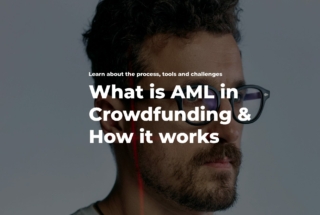Overview of the Crypto Lending and Crypto Crowdfunding Market
A combination of crypto crowdfunding and crypto-investing is a great way to attract the crypto-traders and altcoin investors community to your crowdfunding platform. The concept allows investors to lend cryptocurrency and earn interest ranging from 4% to 17% yearly. However, investors can also lend fiat money to borrowers who offer crypto-assets as collateral for the loan.
What you will learn in this post:
What is crypto lending?
Crypto-lending works similar to traditional lending. A borrower gives crypto as collateral and receives fiat money from a lender. The collateral crypto is kept by the lender until the borrower repays the loan and the generated interests.
If a borrower fails to repay the loan, the lender can liquidate or cash out the collateral crypto, in full or partially, to compensate for the losses.
How crypto lending platforms work
Crypto-lending for interests is enabled by crypto lending platforms. These platforms are used by both parties of the lending-borrowing process:
- Lenders – those who have some funds and want to make passive income
- Borrowers – those who have a cryptocurrency and need fiat money
There are two main types of crypto lending platforms.
CeFi
CeFi or centralized crypto lending platforms serve as an intermediary between a borrower and a lender. Centralized platforms take control over the crypto collateral by keeping it in a special wallet provided by the platform.
Centralized platforms have to comply with strict regulatory requirements. Therefore, to take a loan there, a borrower needs to register an account on the platform and pass a rigorous KYC process which means no anonymity.
DeFi
DeFi or decentralized platforms serve the same purpose as CeFi but the main difference is that they represent a decentralized approach to crypto lending. All the processes are automated via smart contracts. On DeFi platforms, the entire lending process is automated with smart contracts. Smart contracts are executed when specific conditions are met.
Crypto lending process
Whether you choose a DeFi platform or a CeFi one, the entire lending process looks as follows:
- Lenders contribute in the form of crypto or fiat to get passive income from their funds.
- Borrowers give their crypto as collateral to receive a loan. The borrower’s cryptocurrency is not sold but blocked until the loan and the interests are repaid.
- Once the loan and the interests are repaid, the platform, whether a CeFi or DeFi, regulates the lending and borrowing processes. In the case of a DeFi platform, regulation occurs automatically through smart contracts.
Crypto lending rates and returns
Each platform establishes its own rates for crypto lending. Usually, the yearly yield from crypto lending varies from 3% to 8% for crypto coins, and from 10% to 18% for stablecoins. However, the yearly yield is not the only factor you shall consider for your platform. You shall consider also:
- Deposit limit – some platforms require to deposit not less than a minimum amount while others do not have this requirement.
- Lending duration – fixed or non-fixed.
- Platform risks – some platforms ensure the lent funds while others do not.
- Fees – here, the principle “the lower the better” works. The best option for you is when fees are absent at all.
Examples of crypto lending platforms
There are a lot of crypto lending platforms that’s why choosing one might be time-demanding. Here, we have selected a list of the best platforms based on the above features and other details important for an investor.
| Platform | Features |
 | – No minimum deposit – Unlimited lending duration – Yearly yield up to 17% depending on a coin – 41 coins available |
 | – Minimum deposit 1$ – Up to 90 days lending duration – Yearly yield up to 7% depending on a coin – 58 coins available |
 | – Minimum deposit 250$ – Up to 90 days lending duration – Yearly yield up to 12% depending on a coin – 35 coins available |
 | – No minimum deposit – Unlimited lending duration – Yearly yield up to 9.3% depending on a coin – 10 coins available |
Legal aspects of crypto lending
Along with financial aspects, investors shall also consider legal ones to understand the contractual mechanisms and remedies required to secure the lent crypto. The main aspects to consider are the following:
Regulatory compliance: in some countries, cryptocurrencies are declared illegal. Getting involved in crypto lending would cause not only financial but also legal issues.
Market volatility: check how to safeguard your income from lent funds in a highly volatile environment. In some cases, you might need to request from a borrower more collateral to balance the loan.
Management of collateral: depending on a crypto lending arrangement, a lender may profit from interests, while in others, they can manage the collateral to earn additional yield.
Security of the collateral: ensure the collateral is protected from cyber thefts and respond to the changes in a blockchain such as splits or forks, token sales, and similar.
Taxes: cryptocurrency not only has different statuses in different locations but also can be taxable in some countries or not taxable in others. It is the investor’s responsibility to check whether the interests, the repayment principal, the lent funds are subject to taxes or not.
Repayment terms: make sure you understand clearly how the loan will be repaid. It can be done in cash installments or crypto. The repayment terms might differ, too.
Security enforcement mechanisms: what are the mechanisms to enforce security if required?
Regulatory challenges of crypto lending
Regulators are interested in crypto lending, and new regulations have been imposed recently. One of the main legal considerations for an investor has to do with how regulators view cryptocurrency.
The IRS has defined cryptocurrency as property in the USA. Therefore, any income from crypto lending shall be taxed as income from a property.
The crypto-lending market in the UK is mostly not regulated. The FCA requires all the crypto-companies to be registered with the FCA and comply with the Money Laundering Act, but the registration deadline was postponed to March 31, 2022, and the companies do not hurry to register.
The OECD defines cryptocurrency as a digital financial asset. Therefore, any income defined as a taxable event shall be taxed. However, in different countries, a taxable event is defined in different ways, and what is a taxable event in, say Italy, isn’t one in France. That’s why taxation on income from crypto lending in European countries is still under question. It is expected that a new Proposal for a Regulation of the European Parliament and of the Council on Markets in Crypto-Assets will make things clearer.
In some countries, cryptocurrency is illegal, and in some, it is not regulated at all. That’s why it is necessary to understand cryptocurrency status in your location to understand how to invest in crypto crowdfunding platforms safely.
How to Tackle Challenges with LenderKit
LenderKit helps companies to launch a crypto-lending and crypto-crowdfunding solution in different regulatory frameworks. With LenderKit, you get a fully scalable solution that fits local and international markets. It facilitates compliance, automates operations, and saves time.




